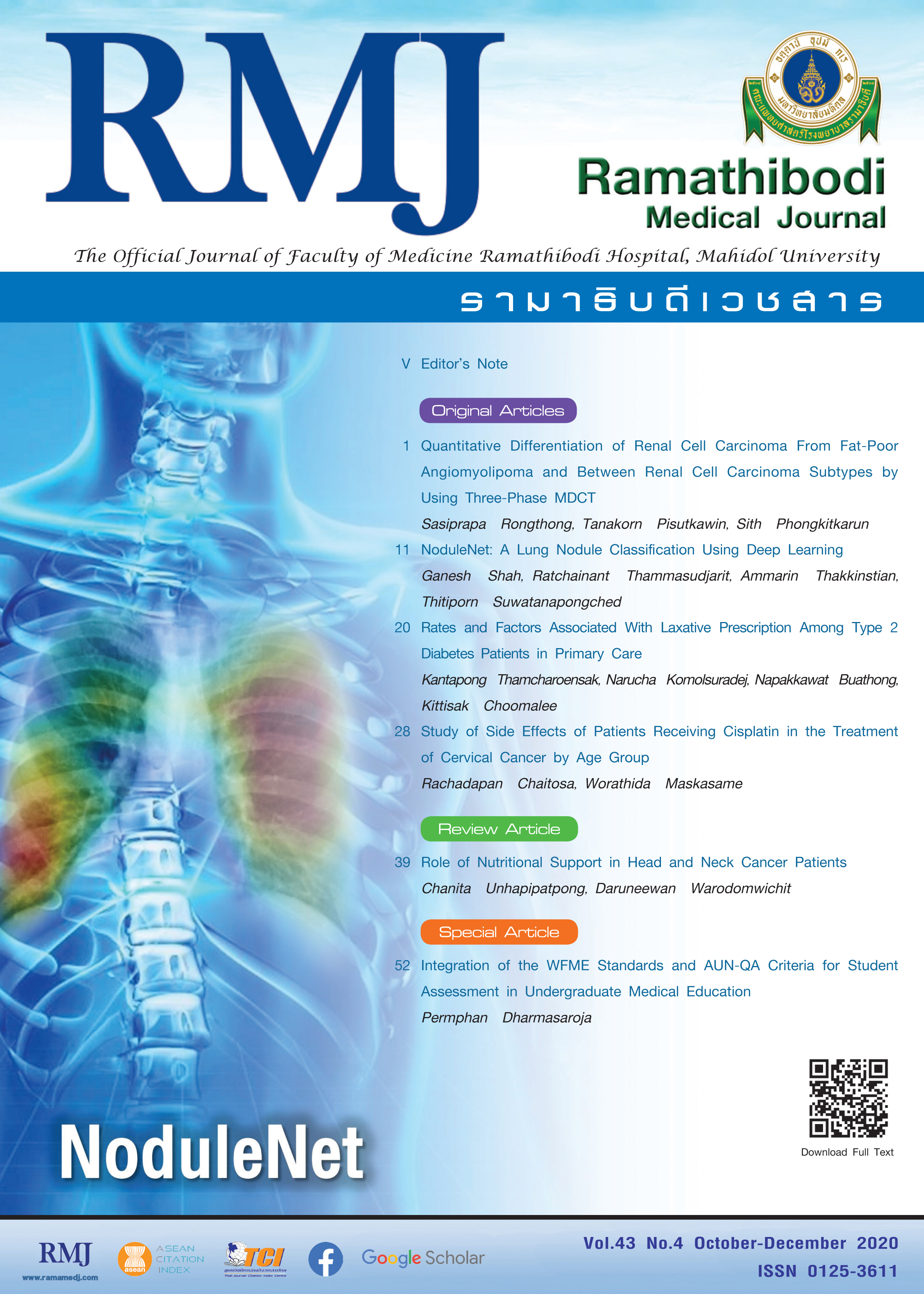Study of Side Effects of Patients Receiving Cisplatin in the Treatment of Cervical Cancer by Age Group
DOI:
https://doi.org/10.33165/rmj.2020.43.4.200444Keywords:
Cisplatin, Side effects, Cervical cancer, AgeAbstract
Background: Cisplatin is one of the options of chemotherapy used to treat cervical cancer. Patient can experience side effects from drugs frequently with many factors as a catalyst including the age of the patient.
Objective: To compare the side effects of cervical cancer patients receiving concurrent chemoradiotherapy (Cisplatin) 2 rounds between patients ≤ 60 years and > 60 years.
Methods: A retrospective study, 70 cervical cancer patients undergoing concurrent chemoradiotherapy at Ramathibodi Hospital were investigated. Questionnaires about adverse effects were completed by patients at home 7 days after 1st and 2nd courses of combined therapy. The side effects of cervical cancer patients between groups was analyzed.
Results: Of 70 patients, there were 47 patients ≤ 60 years and 23 patients > 60 years. After the 1st course, life-threatening side effects occurred in 9 patient’s ≤ 60 years but none occurred in patients > 60 years. Younger patients also had significant more nausea than older patients (P < .05). After the 2nd course, younger patients also had significant more vomiting than older patients (P < .05). The most common side effects for both age groups were fatigue and anorexia respectively.
Conclusions: Patients younger than 60 year would experience significantly more symptoms of nausea and vomiting after the 1st and 2nd courses of concurrent chemoradiotherapy.
References
Petsusiri J, Kakanaporn C. Basic Principles of Radiation Oncology in Gynecologic Cancer. In: Srisomboon J, Kietpeerakool C, eds. Gynecologic Oncology. Bangkok: The Royal Thai College of Obstetricians and Gynaecologists; 2011:355-375.
Division of Therapeutic Radiology and Oncology, Chula Cancer. Education and research: Radiotherapy for cervical carcinoma. https://www.chulacancer.net/education-inner.php?id=388. Accessed January 14, 2020.
Warwick GP. The Mechanism of action of alkylating agents. Cancer Res. 1963;23:1315-1333. https://cancerres.aacrjournals.org/content/23/8_Part_1/1315.full-text.pdf. Accessed January 14, 2020.
Fuertes MA, Castilla J, Alonso C, Pérez JM. Cisplatin biochemical mechanism of action: from cytotoxicity to induction of cell death through interconnections between apoptotic and necrotic pathways. Curr Med Chem. 2003;10(3):257-266. doi:10.2174/0929867033368484.
Kartalou M, Essigmann JM. Mechanisms of resistance to cisplatin. Mutat Res. 2001;478(1-2):23-43. doi:10.1016/s0027-5107(01)00141-5.
Wang D, Lippard SJ. Cellular processing of platinum anticancer drugs. Nat Rev Drug Discov. 2005;4(4):307-320. doi:10.1038/nrd1691.
Johnstone TC, Park GY, Lippard SJ. Understanding and improving platinum anticancer drugs--phenanthriplatin. Anticancer Res. 2014;34(1):471-476.
Petrović M, Todorović D. Biochemical and molecular mechanisms of action of cisplatin in cancer cells. FU Med Bio. 2016;18(1):12-18.
Dasari S, Tchounwou PB. Cisplatin in cancer therapy: molecular mechanisms of action. Eur J Pharmacol. 2014;740:364-378. doi:10.1016/j.ejphar.2014.07.025.
Division of Therapeutic Radiology and Oncology, Chula Cancer. Services: Knowledge of chemotherapy and the side effects of drugs. http://www.chulacancer.net/services-list-page.php?id=352#5. Accessed January 14, 2020.
Sookpresert A. A step by step practical guide before giving chemotherapy. Presented as part of Workshop and Traineeship for Oncology Pharmacy Practitioners; 2011:40-56. http://thaihp.org/index2.php?option=showfile&tbl=home&id=972. Accessed January 14, 2020.
Department of Older Persons, Ministry of Social Development and Human Security. The Act on the Elderly, B.E. 2546 (2003 A.D.). Bangkok: Ministry of Social Development and Human Security; 2010. http://www.dop.go.th/download/laws/regulation_th_20160807155130_1.pdf. Accessed January 14, 2020.
Yuen AR, Zou G, Turrisi AT, et al. Similar outcome of elderly patients in intergroup trial 0096: Cisplatin, etoposide, and thoracic radiotherapy administered once or twice daily in limited stage small cell lung carcinoma. Cancer. 2000;89(9):1953-1960. doi:10.1002/1097-0142(20001101)89:9<1953::aid-cncr11>3.3.co;2-y.
Langer CJ, Manola J, Bernardo P, et al. Cisplatin-based therapy for elderly patients with advanced non-small-cell lung cancer: implications of Eastern Cooperative Oncology Group 5592, a randomized trial. J Natl Cancer Inst. 2002;94(3):173-181. doi:10.1093/jnci/94.3.173.
US Department of Health and Human Services, National Institutes of Health, National Cancer Institute. Common Terminology Criteria for Adverse Events (CTCAE) Version 5.0. https://ctep.cancer.gov/protocoldevelopment/electronic_applications/docs/CTCAE_v5_Quick_Reference_8.5x11.pdf. Published November 27, 2017. Accessed January 14, 2020.
Molassiotis A, Saunders MP, Valle J, et al. A prospective observational study of chemotherapy-related nausea and vomiting in routine practice in a UK cancer centre. Support Care Cancer. 2008;16(2):201-208. doi:10.1007/s00520-007-0343-7.
Pirri C, Katris P, Trotter J, Bayliss E, Bennett R, Drummond P. Risk factors at pretreatment predicting treatment-induced nausea and vomiting in Australian cancer patients: a prospective, longitudinal, observational study. Support Care Cancer. 2011;19(10):1549-1563. doi:10.1007/s00520-010-0982-y.
Cox JD, Stetz J, Pajak TF. Toxicity criteria of the Radiation Therapy Oncology Group (RTOG) and the European Organization for Research and Treatment of Cancer (EORTC). Int J Radiat Oncol Biol Phys. 1995;31(5):1341-1346. doi:10.1016/0360-3016(95)00060-C.
Gibson RJ, Keefe DM. Cancer chemotherapy-induced diarrhoea and constipation: mechanisms of damage and prevention strategies. Support Care Cancer. 2006;14(9):890-900. doi:10.1007/s00520-006-0040-y.

















